So kiwi (or kiwifruit) is in season, and you’ve stumbled upon a great sale. Who wouldn’t take advantage of it?
You’ve bought a whole bunch, and now you’re worried that some might go bad. That means right now you’re desperately looking for ways to make them last longer. And freezing seems to be the obvious choice.
The only issue is that, as you already know, some fruits freeze well, while others not so much. And you’re not quite sure to which group kiwi belongs to. In other words, you’re not sure if freezing kiwifruit makes sense at all, and how to freeze kiwi if it does. That’s why I put together this guide, so you can learn about the pros and cons of freezing kiwis, and decide if it’s the way to go for your situation.
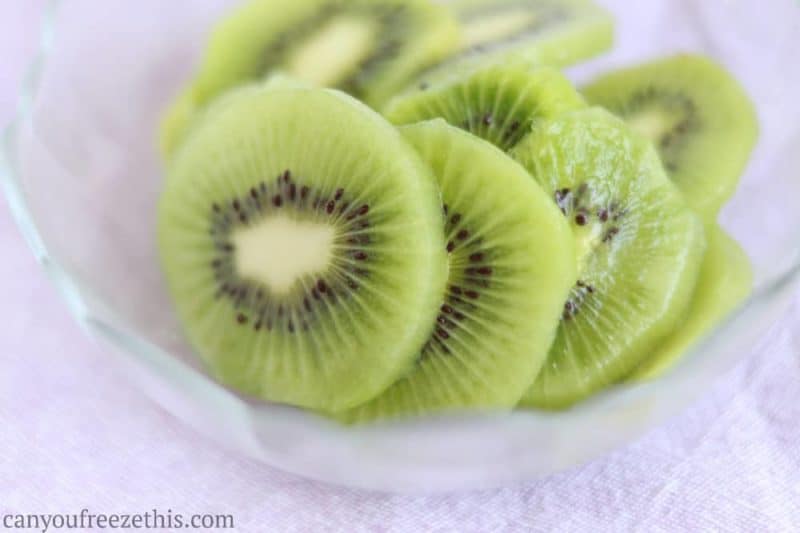
Can You Freeze Kiwi?
Kiwis last quite a long time in the fridge, so quite often you can use all of them before they deteriorate.
Okay, so you know that refrigerated kiwifruit lasts quite some time. But that’s still not enough. Maybe you’re going on vacations for a couple of weeks, or your fridge is permanently full (like mine). Because of that, freezing seems to be your last resort. Hence the question: can you freeze kiwi?
Well, similarly to other fruit, like e.g., mango, the texture of kiwi changes once you thaw it. Basically, kiwifruit becomes mushy. And that difference is definitely noticeable to anyone who pays attention. Here’s how thawed kiwi slices look like:
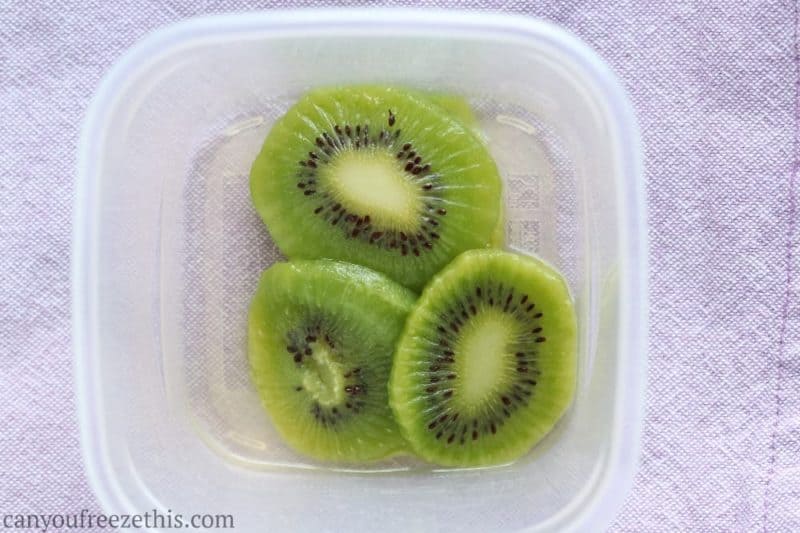
And here’s a close-up of a single slice:
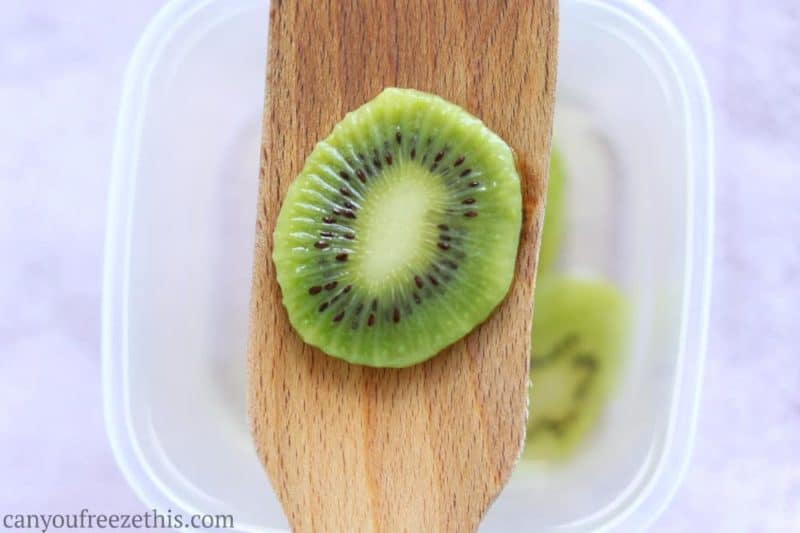
As you can tell, there’s some water in the container, even though I defrosted only a few slices. And the slices are mushy compared to fresh kiwifruit.
All in all, freezing kiwi for either cooked or blended dishes is fine, but eating it as-is or in a fruit salad is iffy. If you’d like to go with the latter, thaw and strain the kiwi before sticking it into the salad bowl. And make sure that thawed fruit are only a small portion of the salad.
How to Freeze Kiwi?
While freezing whole peeled kiwis is an option, it has quite a lot of downsides. Whole kiwis take a lot of space, and defrosting takes some time too. Plus the fruit tends to become super mushy, and that’s not what you’re looking for.
A better way of going about this is to freeze kiwi sliced or even diced. This way it’s easier to fit it into the freezer, and you can defrost only as much as you need at a time. The fruit still loses some of its texture, but it’s not as bad as if you would’ve frozen it whole.
Freezing Kiwi Slices
That’s the easiest and quickest way to freeze this fruit. It takes only a couple of minutes of active time and yields okay results. Here’s how to go about it:
- Peel the fruit and slice or dice it. Slicing it is super fast, but if you plan on using it frozen in a smoothie, and your blender isn’t exactly a force to be reckoned with, dicing might be the way to go. Same thing if that kiwi will end up in a fruit salad. In short, think about how you’re going to use the frozen fruit and cut it accordingly.
- Line a cookie sheet or shallow casserole dish with baking paper or a freezer-safe silicone mat. The lining will make sure you can easily remove the frozen fruit from the surface.
- Transfer the slices or chunks onto the dish in a single layer. Make sure the pieces don’t touch each other so that they won’t freeze together. You can coat the slices with sugar. Use about 1 cup of sugar per 4 cups of slices (KFF). Sugar-coated fruit retains quality for longer (UM), but besides the fruit, you also eat a bunch of sugar, so it up to you.
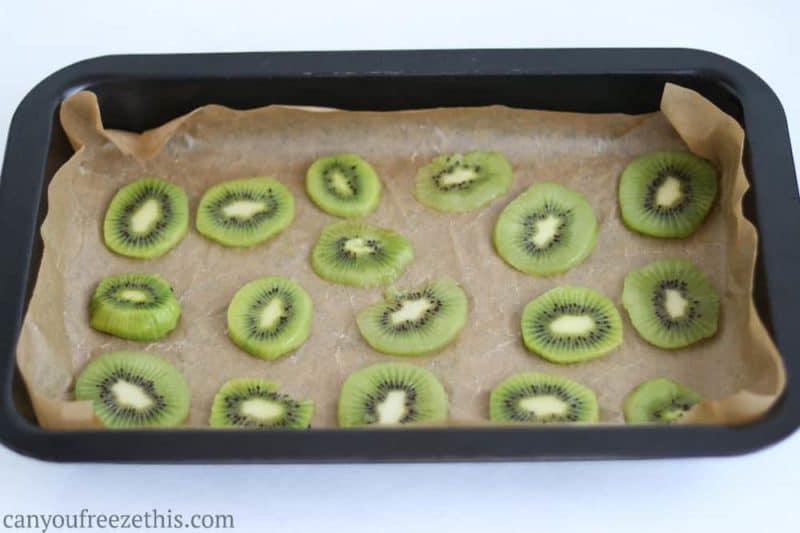
Sliced kiwi on a cookie sheet - Put the cookie sheet in the freezer and keep it there until the fruit freezes. I usually leave it overnight to be sure it’s frozen throughout.
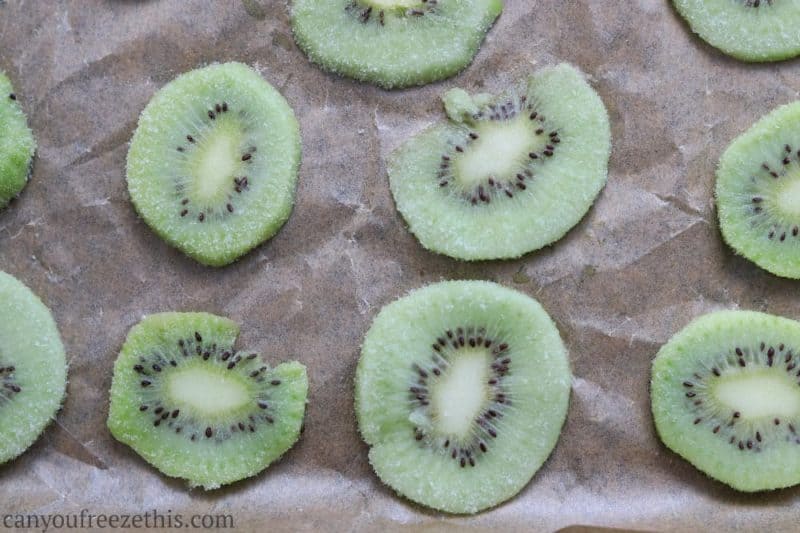
Frozen kiwi slices - Remove the slices from the dish and transfer them into a freezer bag or container.
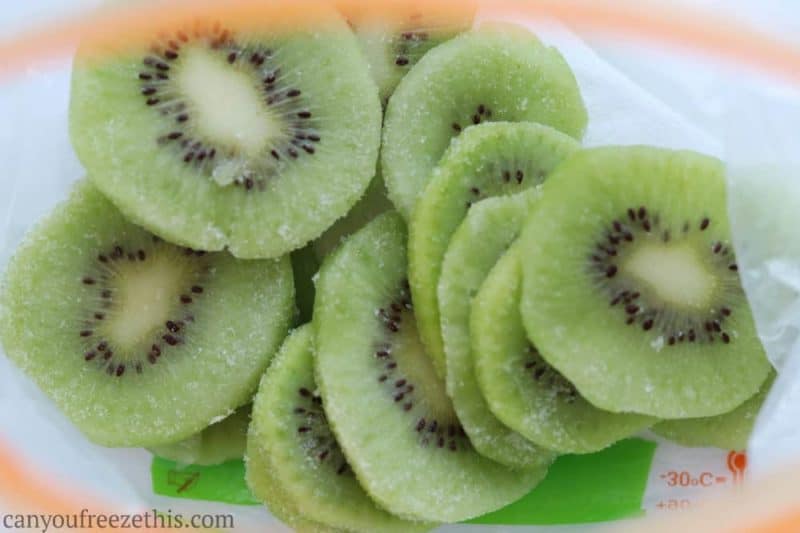
Frozen kiwi slices in a freezer bag - Add a label if necessary, and transfer the fruit into the freezer for long-term storage.
Freezing Kiwi in Sugar Syrup
Freezing fruit in sugar syrup is another popular method. All you need is some airtight containers, water, sugar, and perhaps some ascorbic acid (vitamin C) or commercial fruit preservatives to help. The process takes a bit longer than the previous method, and a lot more real estate in the freezer, but that’s about it. Here’s what to do:
- Prepare sugar syrup. Grab the containers and prepare the simple syrup by adding 3 cups sugar per every 4 cups of water (KFF) and stirring it together. If you want even better results, add in a teaspoon of ascorbic acid or fruit preservative per 4 cups (KFF).
- Prepare the fruit and transfer to the containers. Peel the kiwis and cut them up into chunks or slices. Then add them to the containers making sure the sugar solution covers the fruit. Also, remember to leave some head-space in each container, as water expands when frozen.
- Seal the containers tightly. If you find it useful, add a label with name and date for future reference.
- Stick everything in the freezer. Make sure it’s standing upright.
How to Defrost Frozen Kiwi?
When it comes to thawing, the same as usual methods apply. That means you can:
- Thaw the fruit overnight in the fridge. Throw it in the evening, and it should be defrosted in the morning.
- Defrost in cold water. Since water is better at conducting temperature than air, the defrosting process takes less time, usually a couple of hours tops (depending on the amount and size of the fruit).
- Don’t defrost at all. If you’re adding the fruit to a smoothie, you can get away without defrosting it first. Plus it will help make the smoothie cold.
How To Use Frozen Kiwi?
It’s not as easy to buy frozen kiwis as it is to buy, e.g., frozen strawberries or blackberries. And the reason is people neither need nor use frozen kiwis that often. But because you’ve already frozen the fruit, let’s make good use of it, shall we?
Here are a couple of popular options when it comes to using frozen kiwi:
- Add it to your smoothie. Like with pineapples and mangoes, smoothie is a perfect use of frozen fruit. Throw in the kiwi without defrosting and add a bit less liquid than you normally would to account for some water from the kiwi.
- Use it in salsas and sauces, especially ones that you blend. A kiwi might be a great fruit addition to any salsa or sauce that could use some natural sweetness. Thaw and strain the kiwi, so it doesn’t water down the whole thing that much. Bonus points if you run the sauce through a blender, so the somewhat-mushy texture of kiwi doesn’t stand out at all.
- Use in a fruit salad. Thaw the kiwis and strain them before adding to the salad. And make sure NOT to make kiwi the main ingredient of that salad so that the texture change won’t be as noticeable.
How Long Does Kiwi Last and How To Store It?
If you’re not familiar with the shelf life of kiwifruit, this short section is super important. That’s because kiwi has a surprisingly long shelf life. While it keeps for only several days in room temperature once ripe, it can last even up to 4 weeks (KFS) in the vegetable drawer in the fridge. So if your kiwis are already mature and stored in the pantry, you can transfer them to the refrigerator, and voila, you have added 3 to 4 weeks of shelf life. Often that’s long enough to go through most of your supplies.
| Pantry | Fridge | |
|---|---|---|
| Fresh ripe whole kiwi | 2 – 4 days | 3 – 4 weeks |
| Sliced or diced kiwi | 3 – 5 days |
References
- KFS Kiwifruit: Storing Kiwifruit
- KFF Kiwifruit: Freezing Kiwifruit
- UM University of Minnesota Extension: How to freeze fruit for the best flavor
About the Author

Marcin is the managing editor of CanYouFreezeThis.com. He is making sure all the freezing info on this page is accurate and the posts easy to digest and use.